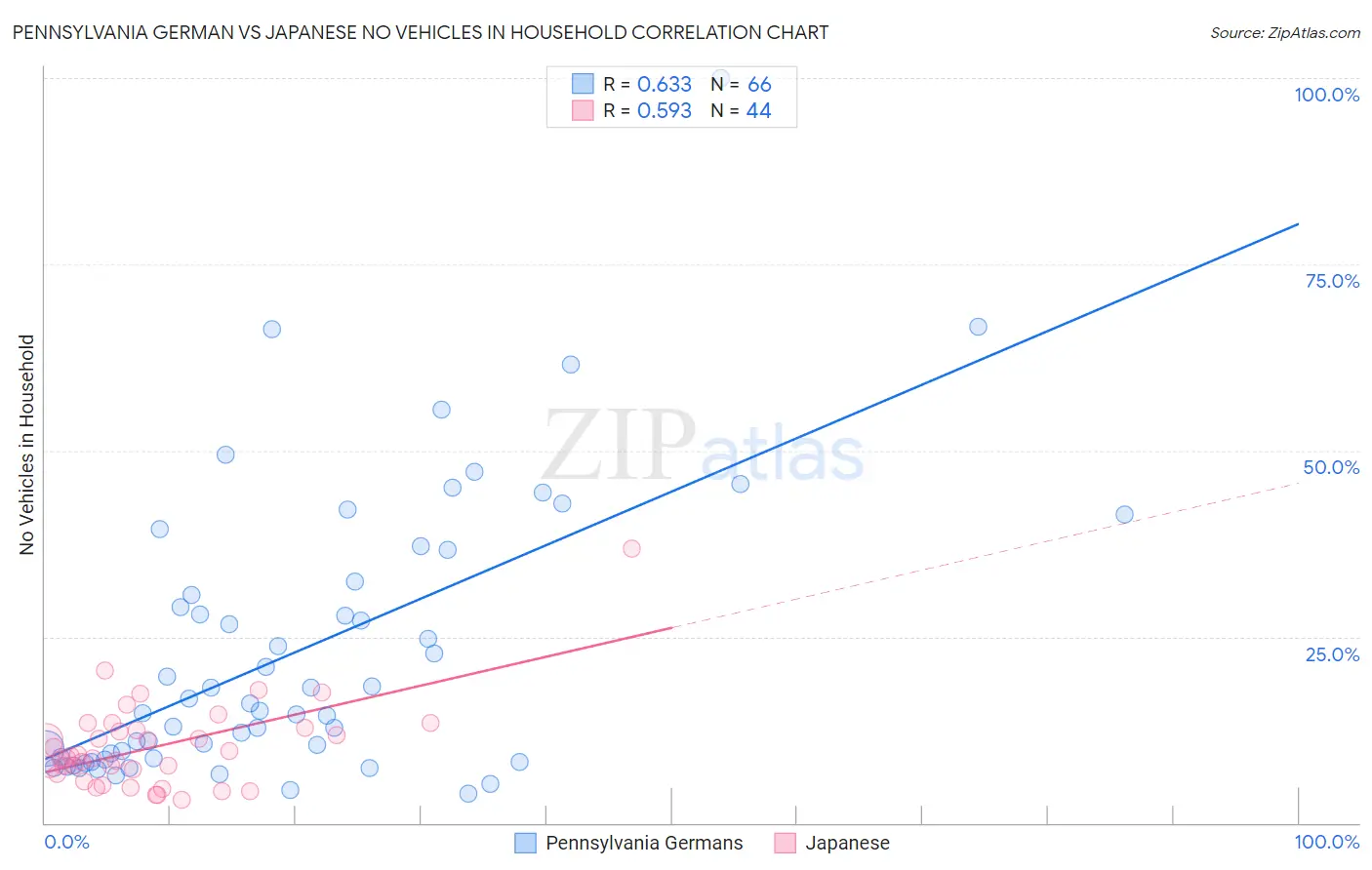Pennsylvania German vs Japanese No Vehicles in Household
COMPARE
Pennsylvania German
Japanese
No Vehicles in Household
No Vehicles in Household Comparison
Pennsylvania Germans
Japanese
11.0%
NO VEHICLES IN HOUSEHOLD
15.5/ 100
METRIC RATING
209th/ 347
METRIC RANK
9.4%
NO VEHICLES IN HOUSEHOLD
94.1/ 100
METRIC RATING
116th/ 347
METRIC RANK
Pennsylvania German vs Japanese No Vehicles in Household Correlation Chart
The statistical analysis conducted on geographies consisting of 233,622,955 people shows a significant positive correlation between the proportion of Pennsylvania Germans and percentage of households with no vehicle available in the United States with a correlation coefficient (R) of 0.633 and weighted average of 11.0%. Similarly, the statistical analysis conducted on geographies consisting of 248,891,204 people shows a substantial positive correlation between the proportion of Japanese and percentage of households with no vehicle available in the United States with a correlation coefficient (R) of 0.593 and weighted average of 9.4%, a difference of 16.7%.

No Vehicles in Household Correlation Summary
| Measurement | Pennsylvania German | Japanese |
| Minimum | 4.0% | 3.2% |
| Maximum | 100.0% | 36.9% |
| Range | 96.0% | 33.7% |
| Mean | 23.2% | 10.2% |
| Median | 15.5% | 8.9% |
| Interquartile 25% (IQ1) | 8.7% | 6.9% |
| Interquartile 75% (IQ3) | 32.5% | 12.6% |
| Interquartile Range (IQR) | 23.8% | 5.6% |
| Standard Deviation (Sample) | 19.0% | 5.9% |
| Standard Deviation (Population) | 18.9% | 5.8% |
Similar Demographics by No Vehicles in Household
Demographics Similar to Pennsylvania Germans by No Vehicles in Household
In terms of no vehicles in household, the demographic groups most similar to Pennsylvania Germans are Immigrants from Italy (11.0%, a difference of 0.030%), Sierra Leonean (11.0%, a difference of 0.050%), Immigrants from Chile (11.0%, a difference of 0.10%), Somali (11.0%, a difference of 0.10%), and Guatemalan (11.0%, a difference of 0.14%).
| Demographics | Rating | Rank | No Vehicles in Household |
| Romanians | 17.9 /100 | #202 | Poor 10.9% |
| Iroquois | 17.6 /100 | #203 | Poor 10.9% |
| Guatemalans | 16.1 /100 | #204 | Poor 11.0% |
| Immigrants | Chile | 15.9 /100 | #205 | Poor 11.0% |
| Somalis | 15.9 /100 | #206 | Poor 11.0% |
| Sierra Leoneans | 15.7 /100 | #207 | Poor 11.0% |
| Immigrants | Italy | 15.6 /100 | #208 | Poor 11.0% |
| Pennsylvania Germans | 15.5 /100 | #209 | Poor 11.0% |
| Apache | 14.8 /100 | #210 | Poor 11.0% |
| Crow | 14.2 /100 | #211 | Poor 11.0% |
| Immigrants | Western Asia | 13.9 /100 | #212 | Poor 11.0% |
| Immigrants | Hungary | 12.3 /100 | #213 | Poor 11.1% |
| Immigrants | Denmark | 12.1 /100 | #214 | Poor 11.1% |
| Immigrants | Sri Lanka | 10.6 /100 | #215 | Poor 11.2% |
| Immigrants | Argentina | 10.6 /100 | #216 | Poor 11.2% |
Demographics Similar to Japanese by No Vehicles in Household
In terms of no vehicles in household, the demographic groups most similar to Japanese are Navajo (9.4%, a difference of 0.070%), Serbian (9.4%, a difference of 0.13%), Chippewa (9.4%, a difference of 0.17%), Immigrants from Netherlands (9.4%, a difference of 0.56%), and Armenian (9.4%, a difference of 0.66%).
| Demographics | Rating | Rank | No Vehicles in Household |
| Maltese | 97.6 /100 | #109 | Exceptional 9.1% |
| Delaware | 97.2 /100 | #110 | Exceptional 9.2% |
| Immigrants | Kuwait | 95.1 /100 | #111 | Exceptional 9.4% |
| Armenians | 95.0 /100 | #112 | Exceptional 9.4% |
| Immigrants | Netherlands | 94.8 /100 | #113 | Exceptional 9.4% |
| Serbians | 94.3 /100 | #114 | Exceptional 9.4% |
| Navajo | 94.2 /100 | #115 | Exceptional 9.4% |
| Japanese | 94.1 /100 | #116 | Exceptional 9.4% |
| Chippewa | 93.8 /100 | #117 | Exceptional 9.4% |
| Greeks | 92.9 /100 | #118 | Exceptional 9.5% |
| Fijians | 92.7 /100 | #119 | Exceptional 9.5% |
| Immigrants | Thailand | 92.6 /100 | #120 | Exceptional 9.5% |
| Puget Sound Salish | 92.4 /100 | #121 | Exceptional 9.5% |
| Costa Ricans | 92.3 /100 | #122 | Exceptional 9.5% |
| Blackfeet | 91.4 /100 | #123 | Exceptional 9.6% |